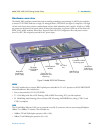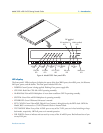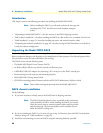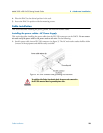
1 • Introduction
Model 3095 mDSL DACS Getting Started Guide
16
Hardware overview
• Auto detection and fallback
• 10/100 Mbps link and status indicators
RS-232 control port
The RS-232 port provides for initial configuration of the Model 3095. The RS-232 port supports:
• Asynchronous data rates of 19.2 kbps, 8 data bits, no parity, 1 stop bit.
• An RJ-45 connector with EIA-561 pinouts
• A management interface that supports VT-100 terminals
• Hardware flow control (RTS and CTS)
• Hardware CD and DTR signals for external modems
Power system
• Internal dual-redundant, load-sharing power supplies
• Universal-input voltage range, 90-264 VAC, 50/60 Hz via IEC-320 connectors
• Optional DC power supply with -36 to 72VDC via 2-position power block
Central processing unit
The 3095 employs an Intel i960VH RISC processor operating at 100 MHz/100 Mips. The CPU controls the
memory, front/back-panel and management interface for mDSL port/WAN time slot mapping, local switch-
ing, loopback and the management system. The memory holds:
• 4 MB Flash ROM
• 8 MB EDO DRAM
mDSL Ports
The 16 mDSL ports operate at data-rates up to 2.3 Mbps and are accessible via the RJ-21X 50-pin telco con-
nector. Each port uses one twisted-pair (2-wires) for full-duplex communication. The mDSL ports can be con-
centrated into TDM data output on the WAN ports. Other features include:
• CAP line encoding
• "Plug-and-Play" automatic configuration between the 3095’s mDSL multiplexer and the mDSL CPE
modems
• Built-in surge protection
• mDSL configuration parameters and line status indicators accessible to upper-level utility or application
software
Alarm Port
The alarm port notifies the operator that a pre-defined alarm has occurred. The principal features are:
• User-defined alarm condition configured through the NMS
• User selectable major and minor alarms for mDSL, WAN, clocking, power, and over-temperature.


















